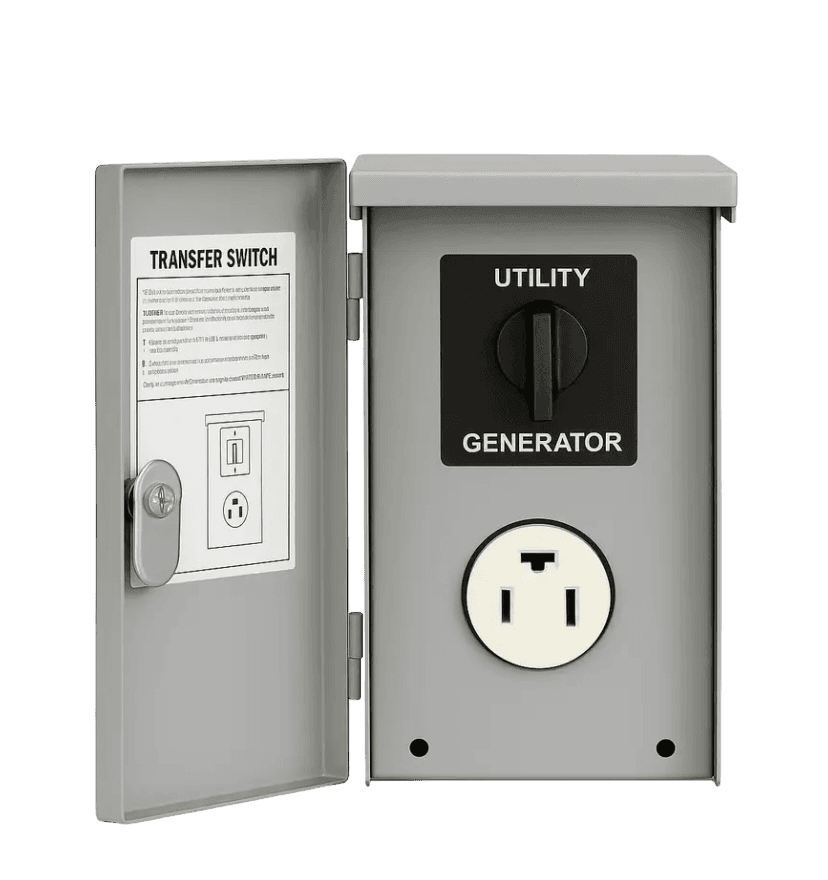- What’s an Electrical Transfer Switch—And Why You Might Want One
- What’s a Transfer Switch?
- How It Works
- How Much Does It Cost?
- What’s an Electrical Transfer Switch—And Why You Might Want One.
- What’s a Transfer Switch?
- How It Works
- How Much Does a Transfer Switch Cost? And what if I can’t afford it?
- Incentives & Programs
- Should You Rent One?
What’s an Electrical Transfer Switch — You Might Want One

What’s an Electrical Transfer Switch—And Why You Might Want One
If you’ve ever lost power during a winter storm, you’ve probably considered getting a generator.
But here’s the catch: running a generator without a proper connection means dragging extension cords through windows and only powering one or two things at a time. That’s where transfer switches come in.
What’s a Transfer Switch?
A transfer switch is a device that safely connects your home’s electrical system to a backup power source—usually a generator.
When the power goes out, the switch transfers your home’s electricity from the grid to the generator. There are two types:
- Manual Transfer Switch: You flip the switch by hand to connect to your generator.
- Automatic Transfer Switch (ATS): This version senses when the power goes out and switches to generator power automatically—no action needed.
How It Works
- The generator starts (either manually or automatically).
- The transfer switch isolates your home from the utility grid.
- Power flows from the generator to key circuits—like your fridge, freezer, sump pump, heat pump, or essential lighting.
- When power is restored, the switch safely returns your home to grid power.
This prevents backfeeding, a dangerous condition where electricity from your generator flows back into utility lines—potentially injuring utility workers or damaging your system.
How Much Does It Cost?
Here’s a ballpark estimate in Canadian dollars:
What’s an Electrical Transfer Switch—And Why You Might Want One.
If you’ve ever lost power during a winter storm, you’ve probably considered a generator.
But here’s the catch: just plugging in a generator to your house means extension cords, and running things on a couple of things at a time. That’s where transfer switches come in.
What’s a Transfer Switch?
A transfer switch is a device that safely connects your home to a backup power source, usually a generator.
When the power goes out, it “transfers” your home’s electricity from the grid to the generator. There are two main types:
- Manual transfer switch: You physically flip the switch to change over to generator power.
- Automatic transfer switch (ATS): Detects a power outage and switches over automatically—hands-free backup.
How It Works
- You fire up your generator (or it starts automatically).
- The transfer switch shifts your home’s electrical load from the grid to the generator.
- You get power to essential circuits—think fridge, freezer, heat pump, sump pump, maybe a few lights.
- When grid power returns, the switch safely transfers everything back.
This prevents “backfeeding”—a dangerous situation where electricity goes from your generator back into power lines, potentially harming utility workers or damaging your home.
How Much Does a Transfer Switch Cost? And what if I can’t afford it?
Here’s a rough breakdown in Canadian dollars:
- Manual transfer switch: $400–$800
- Automatic transfer switch: $800–$2,500
- Installation: $300–$1,500 depending on your home’s setup
- Electrician required: Yes (this isn’t a DIY job unless you’re licensed)
Add a generator and you’re likely looking at $1,500–$5,000+
Incentives & Programs
Now the good part: there are incentives and programs to make this more affordable.
I rent my transfer switch for $25.00 a month through NB Power. Until I can undertake a solar project. The minimum rental is for one year.
There is no big upfront bill and no surprise costs. It’s part of their standby generator program, which helps you prepare for outages without blowing your budget.
They’ll install the switch and wiring. And yes, you will need a generator, which they will help you hook up safely. Or….
Should You Rent One?
If you don’t already have a generator, some providers offer rental packages that include:
- The generator
- Transfer switch
- Installation
- Maintenance
It’s worth comparing rental vs. ownership based on how often your area loses power and what you want to run.
See other energy projects- Time-of-Use Energy”Night‑Owl” Hacks
